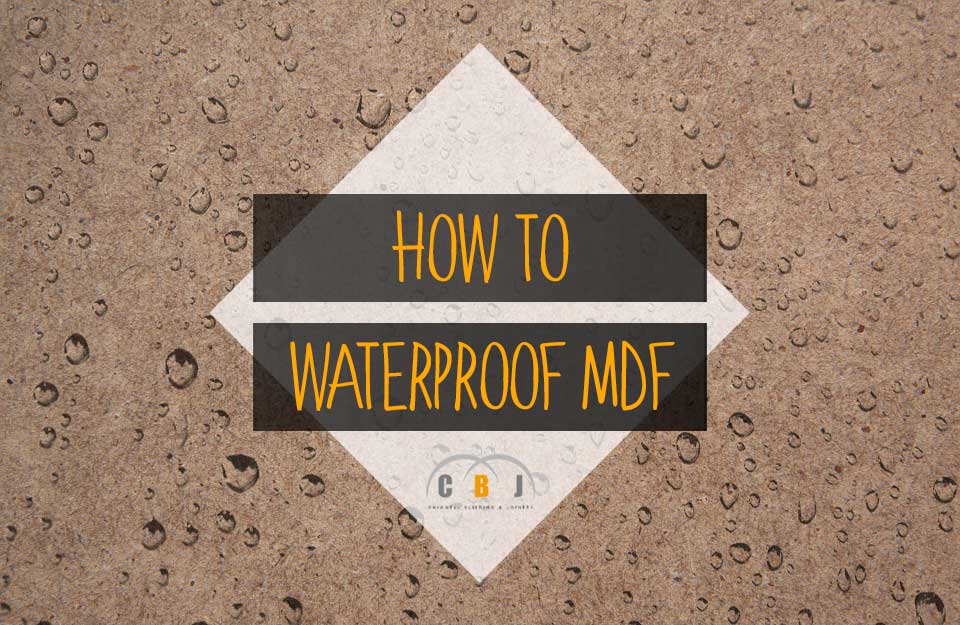
How to Waterproof MDF
Author Chigwell Building & Joinery
Date 30/08/22
MDF is a popular alternative to natural wood utilised in various settings.
MDF is denser than plywood, another synthetic wood, and a relatively cheaper option.
One major problem with MDF is its low tolerance to humid and moist conditions. It tends to absorb water which destroys the material.
In this article, we’ll take an in-depth look at MDF and outline steps to waterproof it effectively.
Table of Contents
- What is MDF?
- Is Standard MDF Waterproof?
- Benefits of Using MDF
- Making MDF Waterproof
- Tools Required
- Conclusion
What is MDF?
Medium-density fibreboard (MDF) is a type of engineered wood.
It consists of wood by-products, shavings, sawdust, and other residual fibres.
The wood by-products are dried and grounded into powder.
It is then mixed with wax and resin and subjected to a high-pressure press into flat panels by mechanical means.
There are various types of MDF, including:
- Standard MDF
- Ultralight MDF
- Moisture Resistant MDF
- Fire Retardant MDF
- Exterior Grade MDF
- Valchromat MDF
- Melamine Faced MDF
Is Standard MDF Waterproof?
Standard MDF is not waterproof, and only short term exposure to water will damage it because it will typically be absorbed.
This exposure will cause the MDF to swell, rendering it useless.
MDF is made of wood fibre bound together by resin adhesive, making it moisture resistant.
But it is not waterproof, and little cuts or prolonged exposure to water will damage it.
For this reason, standard MDF is suited for indoor use, such as for cabinets, shelves, and other objects in places with low moisture or humidity.
Remember that waterproofing your MDF does not offer protection from prolonged exposure to water however.
Benefits of Using MDF
Besides the fact that MDF is less expensive than plywood, there are other benefits to using MDF in your home.
They include:
- MDF's density and shape make it solid and less likely to warp out of shape.
- MDF is easy to drill and cut without damaging the surface. Its durability is due to its composition.
- It works well with carpentry adhesives and polyurethane glues. In addition, MDF glues easily to most materials.
- MDF can easily be fastened together with screws and nails without damaging the surface.
- It is easy to paint.
- MDF can easily be cut and designed to create decorative door panels and other features around the home.
- MDF is a perfect substitute for plastic laminate and veneer as it has the appearance of real wood without the cost.
- MDF is resistant to termites due to the chemicals treatments (such Boric acid, Borax, and urea-formaldehyde) used when manufacturing it.
- MDF is eco-friendly and can be recycled.
Making MDF Waterproof
There are two methods to waterproof MDF.
You can opt for using manufactured Moisture Resistant MDF, which is a little more expensive than standard MDF.
Or you can paint your MDF with moisture-resistant wood sealant or varnish.
Painting your MDF will require you to apply several coats of wood sealant and waterproof paint to its surface.
Either option provides the MDF with protection against moisture.
However, prolonged exposure to water will damage the MDF regardless of the protection provided.
Tools Required
- A quality wood sealant or varnish
- Paintbrush
- Sandpaper
- Roller tray liner
- Roller tray
- ⅜ inch Roller cover
Step One: Prepare Tools
Fix your ⅜-inch roller cover into its roller.
A ⅜-inch roller is recommended to maximise the spread of the paint on the MDF board.
Place a roller tray liner inside the roller tray.
Step Two: Apply Sealer
Apply the sealer to the edges using the paintbrush.
Ensure that all edges are properly covered, and that there’s no drips.
Proceed to apply the sealant to the surface.
We recommend applying at least two coats to the MDF surface.
Let it dry for at least 5 hours.
Clean the surface of the MDF and prepare tools for painting.
There are different sealants for waterproofing.
The most popular method, and the one recommended is primer sealant.
Other methods of sealant include:
Bondo technique
This method involves applying the Bondo filler across the edges and surface of the MDF.
This provides an adequate seal.
The only drawback is Bondo dries easily, and may not be suitable for larger jobs.
Water & glue technique
The technique is cheap and very effective.
It involves mixing water and glue in a container before applying it to the MDF as a sealer.
The only setback of this method is that you may need to add another coat after it has dried, as it’s not always visible during application.
Glazing putty technique
Glazing putty is a great sealer and easy to sand after painting.
It’s not as hard as the Bondo substance however.
Primer technique
Primers are the recommended sealer as they help bond the waterproof coat to the MDF.
Step Three: Apply Moisture-Resistant Paint
The next step is applying the first moisture-resistant paint coat on both sides.
You can sandpaper the edges to ensure a smooth feel.
Once the coat is dried, it is recommended to apply a second coat to ensure the MDF is properly covered.
Paint the edges of the MDF boards too.
Leave the paint to dry for at least two days.
Conclusion
As mentioned above, MDF is a solid alternative to natural wood.
It is also your best bet if you want something aesthetically pleasing, yet more economical than plywood.
Remember, you don't want to expose MDF to humid or moist conditions, so you should be mindful of where you’re going to use it.
There are types of MDF that can work in harsh or wet weather conditions, so you should always do your research before using this highly versatile building material.


